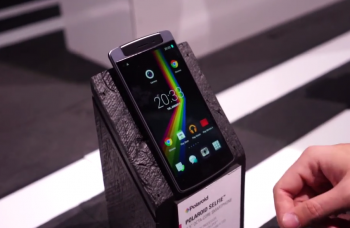
The Polaroid Selfie may be cool, but Oppo’s legal department seems to think otherwise
When we gave you guys a quick look at Polaroid’s latest smartphones, we noted that one device in particular — the Polaroid Selfie — looked a lot like the Oppo N3. That comparison was made mainly due to the device’s top-mounted swivel camera, a module that allows you to take either rear or front photos with the simple swing of the puck holding the camera and LED flash.
But the bad news for Polaroid is that we weren’t the only ones who noticed this similarity. The aforementioned Oppo caught wind of Polaroid’s goods from CES earlier this week themselves, and you can imagine they weren’t necessarily delighted with what they saw.
Of course, that doesn’t mean much considering the Oppo N1 (pictured to the right, review right here) first brought this interesting design in manual fashion, so Oppo has dibs to the “first” and “mine” claims on both fronts.
And if Oppo is to be believed, this isn’t a simple call-out: they’ve actually patented this design, and they tell Phandroid that they won’t hesitate to pursue legal action to make sure they protect what’s rightfully theirs. Said in context by Oppo:
OPPO has not licensed the design of the rotating camera to any third parties, nor has us done that in any OEM way. We will continue to keep track of the event and reserves the right to take further legal action.
The word “design” in the quote above is worth noting, as there is a clear distinction between a utility patent (one that describes a function) and a design patent (one that describes the implementation or design of a function) according to the USPTO.
It’s possible Oppo is referring to the design of the swivel, which they certainly have grounds to call foul on considering the two modules look almost indistinguishable. Of course, if Oppo’s patent was registered at a different patent office that recognizes different definitions, things could be a bit iffy.
That tidbit also becomes very noteworthy when you consider Oppo wasn’t the first to utilize a swiveling camera. Samsung’s old PocketPC device i700 — seen below — had a swiveling camera of its own, though the design of it is much different. (Thanks to Hoby in the comments section for the assist!)
Phandroid attempted to track down the patents in question in either the United States Patent and Trademark Office or Chinese patent and trademark offices to see if we can gain a better understanding of what Oppo believes Polaroid is infringing, but we have been unable to find them as of the time of this writing.
We’ve requested a copy or a link to the patents from Oppo, but in the meantime we can’t help but to think they have pretty good reason to feel slighted. We’ve reached out to both Oppo and Polaroid for further comment, and will provide updates as we get them.